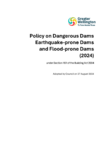If you are a dam owner or own a property with a dam or a similar structure greater than 4m high that retains more than 20,000m3 of water or some other fluid (such as dairy effluent), you need to be aware of the dam safety regulations.
If you are constructing a new dam, or altering an existing dam, you’re likely to require a building consent if your dam is 4 or more meters high and will hold greater than 20,000 cubic meters of water or other fluid. You may also require resource consent under the Resource Management Act 1991 to dam or divert water.
Council recently adopted the Policy on Dangerous Dams, Earthquake-prone Dams and Flood-prone Dams 2024:
Policy on Dangerous Dams Earthquake-prone Dams and Flood-prone Dams (2024)


date_range Published 27 Aug 2024
Download now (PDF 136 KB) get_appDam safety regulations for classifiable dams
On 13 May 2024, new regulations (Building (Dam Safety) Regulations 2022) come into effect to improve the safety and resilience of New Zealand’s dams.
Purpose of the regulations
The regulations have been made to provide a nationally consistent approach to dam safety, will protect people, property and the environment from the potential impacts of dam failure.
Owners of ‘classifiable dams’, who have limited or no dam safety procedures in place, need to become familiar with their responsibilities under the Building Act 2004 and the regulations, and with the actions they must take, and by when.
Dams affected by the regulations
The regulations apply to ‘classifiable’ dams which have a height of 4 or more metres, and store 20,000 or more cubic metres of water or other fluid.
The new regulations do not apply to dams that are less than four meters high (as was initially proposed). This aligns better with the building consent threshold, that is, if a dam owner doesn’t need a consent to build the dam, then it won’t need to be classified after construction.
More information on managing dams to ensure they are safe.
How to comply with the regulations
Dam owners have the primary responsibility for identifying, monitoring, and reporting on dangerous, earthquake-prone, and flood-prone dams, and for reducing or removing the risk of harm to people, property, and the environment in a timely and effective manner.
All owners of a classifiable dam must undertake the following:
- Submit the certified Potential Impact Classification (PIC) of their dam to council by 13 August 2024.
- Review the PIC every 5 years.
Owners of a dam with a medium or high PIC must undertake these additional requirements:
- Submit a certified dam safety assurance programme (DSAP) to council.
- Undertake a dam safety review.
- Submit an annual compliance certificate.
- Review the DSAP every 5-10 years.
Owners of dams classified as ‘low potential impact’ will have few responsibilities - most smaller dams are not impacted by the regulations.
Read step by step information on how to comply with these regulations.
Download the relevant Dam Safety Scheme forms – PIC, DSAP, annual compliance certificate.
Implementation and timeframes
Owners of classifiable dams were required to submit their PIC by 13 August 2024. If you missed this deadline please contact us as soon as you become aware of the requirement and we will help you become compliant.
Failure to classify a dam is an offence under the Building Act, with infringements of $500 and fines up to $50,000 for individuals and $150,000 for corporate entities.
Find out what timeframes apply to your dam.
Learn more by visiting Dam Safety Regulations FAQ’s.
If you have any questions, please email our team at damsafety@gw.govt.nz.
Building consents for new dams or alterations
The Building Act 2004 (the Act) gave responsibilities relating to dams to Regional Authorities - Regional Councils and Unitary Authorities.
Building control functions and the dam safety scheme only apply to large dams. A large dam is one that has a height of 4 or more metres, and holds 20,000 cubic metres or more of water or other fluid. The construction of dams that are not large do not require a building consent but are still required to comply with the building code.
Greater Wellington has transferred most of its building control functions to Waikato Regional Council. Waikato Regional Council has specialist expertise on the building consent process and is accredited as a Building Consent Authority (BCA).
Further information on the building consent process, application forms and checklists can be found on the Waikato Regional Council website. We recommend you liaise directly with Waikato Regional Council about your building consent requirements as Waikato Regional Council has the necessary expertise.
A project information memorandum (PIM) is required by Waikato Regional Council to accompany a building consent application. A PIM details the information a council knows about site where the proposed dam is to be constructed, or an existing dam is altered. You will need to apply for a PIM from both Greater Wellington and the city or district council, responsible for the area where the work is proposed.
Dams Policy
The Building Act 2004 requires Greater Wellington to adopt a policy on Dangerous Dams, Earthquake-prone dams, and Flood-prone dams. In August 2024 following public consultation, Council adopted the Policy on Dangerous Dams, Earthquake-prone Dams and Flood-prone Dams 2024:
Policy on Dangerous Dams Earthquake-prone Dams and Flood-prone Dams (2024)


date_range Published 27 Aug 2024
Download now (PDF 136 KB) get_appThe policy sets out the approach and priorities Greater Wellington will take in performing its functions in relation to dangerous dams and earthquake or flood-prone dams, and how the policy will apply to heritage dams.
Get in touch
- Phone:
- 0800496734
- Email:
- info@gw.govt.nz
